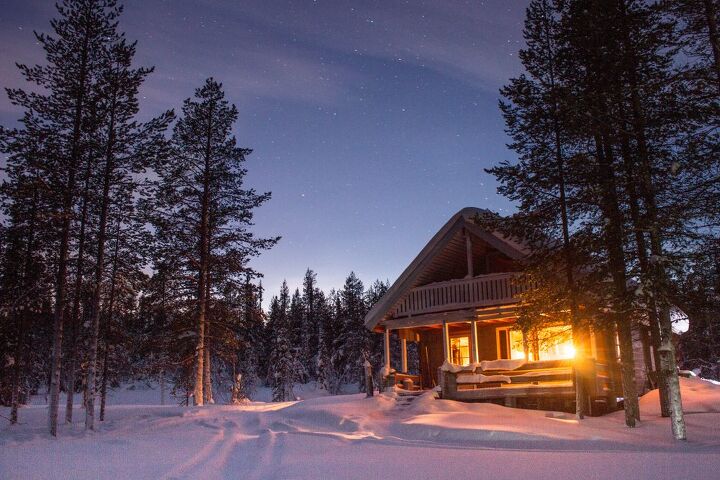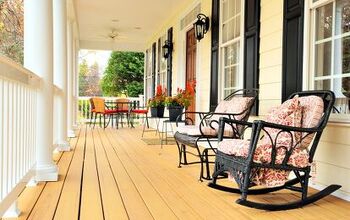11 Types Of Cabins (With Photos)

Cabins are instantly recognizable and evoke a classic vibe that is unique to that type of structure. They come in a wide variety that differs in price, construction, and style. So, what are the different types of cabins, and what makes them unique?
Timber frame, full scribe, stick-built, and handcrafted log cabins are the most common variety. Modular cabins are inexpensive and easy to install in preconstructed sections that reduce construction costs. Cabins made of milled and handcrafted logs are the most expensive to install, and they can last up to 100 years.
Choosing a cabin ultimately comes down to practicality, location, aesthetic, and price. Whether you are a DIYer or plan to hire a contractor, it’s important to know how each type of cabin differs.
Do You Need to Hire an Architect or a Builder?
Get free, zero-commitment quotes from pro contractors near you.

1. Stick-Built
Stick-built cabins may sound rough around the edges, but they are quite elaborate. They have a stick and stud frame and can take a long time to construct from the ground up. You can find stick-built cabins that are antiquated and rustic, or fully functional and modernized.
However, stick-built cabins are expensive to build, and the kitchen alone costs an average of $15 per square foot. Prices vary based on whether your logs are milled, handcrafted, and scribed, or precut in a factory. Customization is one of the key benefits of stick-built cabins, and you can easily craft a dream home out of timber and studs.
2. Full Scribe
Full scribe cabins offer the most energy efficiency, and they have impressive structural integrity. The logs come together horizontally via grooves that help lock them in place. It is possible to build any size cabin in full scribe style, and full scribe cabins are often used as homes.
You can build a full scribe cabin using handcrafted logs instead of milled logs, but that is much pricier. It is important to use woods like red cedar that can deter bugs and pests that would weaken your logs. They are expensive because professionals use power tools to cut and scribe each log by hand, and that is worth the extra cost.
Full scribe cabins have been known to withstand heavy rain, strong winds, and water damage. You don’t need additional materials such as siding and drywall, and that makes full scribe cabin construction go by quickly. It takes an average of 2 months to build a full scribe cabin, but it can go by much faster than that.
3. Timber Frame
Timber frame cabins look unique from lodges, full scribe, and milled cabins. The name comes from the timber posts that act as a frame and are often cut into squares. Timber frame cabins often have siding, insulation, and drywall to insulate and fortify the structure.
You can greatly increase your energy efficiency with a timber frame cabin, as long as it is sealed. It is common to find timber frame cabins with distinct trusses that add character and are instantly recognizable. Customization is possible with timber frame cabins, and it is common to make them look flush with the surrounding woods.
4. Milled
Milled log cabins are instantly recognizable and have arguably the most classic look. The logs are cut to fit together perfectly, and milled log cabins are sturdy structures. Round logs are common with milled cabins, but square logs also create an old-fashioned look.
You can insulate milled log cabins to increase heat retention and keep the cold air out in the fall and winter. It is possible to have logs cut into a variety of shapes for a milled log cabin, especially when you hire a contractor. The combination of log siding with milled logs makes it easier to keep pests out and retain energy efficiency.
5. Modular
Modular cabins are specifically designed so that you can install them quickly and cheaply. There is just as much of a variety within the world of modular cabins as there is for standard cabins. Modular cabins look convincingly like a traditional cabin that was built on-site, but they are built off-site.
Professionals construct modular cabins off-site, transport them to the location, and install them in sections. This can help you cut costs, save time, and ensure an end product that’s just as impressive as traditional cabins. Once the site is prepared, professionals can install a modular cabin in 1-2 days.
6. Lodge
Lodges and cabins are often contested as being different things, but lodges are simply larger cabins. Generally, lodges are different because they are less of a space for housing and more a place for recreation. That isn’t always the case, and lodges are often used as dwellings throughout the year.
There is no hard and fast rule when it comes to lodges, but they’re generally bigger than a standard cabin. It is common to find lodges that are open to fishermen and hunters, but they are often private. Lodges can be made in all of the same styles as typical cabins, but their size makes them more expensive to construct.
When it comes down to it, lodges are more suitable for recreation than sleeping compared to cabins. Not all lodges have accommodations for a kitchen or even plumbing, but DIYers and professionals can install either.
7. Handcrafted Log
Handcrafted log cabins are what the average person pictures when thinking of a classic cabin. The unique and personal cuts make handcrafted log cabins look more rugged and vintage. You generally have to pay much more for a handcrafted cabin because it is much more labor-intensive.
There is no limit to what kind of design you can choose for a handcrafted log cabin. The main appeal to handcrafted cabins is that they feel natural and evoke rugged historical vibes. You can modernize a handcrafted log cabin with rounded or rectangular logs instead of the classic flat option.
8. Siding
Siding offers you the best of both worlds between aesthetic and functionality. You can add log siding to a cabin either as a way to save on construction costs or to add insulation and drywall. Many homeowners add log siding to an existing cabin that needs further insulation and use the space between the logs and siding to do so.
Log siding is also used in construction for new cabins, and they can reduce materials costs. This is especially helpful for pricey woods such as red cedar which can add a small fortune to construction. You can use log siding for both the interior and exterior of your cabin.
Log siding is a great tool if you are a DIYer building your cabin, and it can greatly reduce how much wood you need. Some log siding is made out of concrete, and that helps protect your cabin from water and wind damage. Choose log siding to reduce costs, protect your wood, minimize mold risk, and make your cabin last longer.
9. Chink
Chink cabins are easy to spot because of the evenly and horizontally stacked logs. You bond the logs together with mortar that helps seal the cabin and makes the structure more durable. The one downside to chink cabins is that you may need to apply more mortar between the logs every few years.
This is primarily common if you recently constructed the cabin, but it is important to keep up with. Chink cabins are the most ideal choice for DIYers because you don’t need to do extensive woodwork. Consider a chink cabin if you want to save money on construction costs and reduce the risk of moisture damage.
Apply your mortar evenly to make your cabin airtight and keep moisture out. You can find chink cabins that have stood for over 100 years with proper maintenance.
10. Post and Beam
Post and beam cabins make use of vertical and horizontal logs that connect to provide a sturdy structure. The frame is usually similar to a stick-built or chink cabin, and the beams add extra support to the ceiling. You have flexibility with post and beam cabins as far as types of wood, and even using log siding or concrete.
It generally costs $40 per square foot for the logs alone, but construction is quick and simple. Some builder-owners use log siding for the exterior of a post and beam cabin to save on costs and add extra insulation. You won’t need to worry about wood warping and shrinking or needing to replace mortar often like with chink cabins.
11. Hybrid
Hybrid cabins make use of logs or log siding as well as traditional home construction materials. The hybrid nature of rustic materials with concrete and or steel provides a classic aesthetic with modern comfort. You can implement as much or as little wood as you choose and still achieve a classic log cabin aesthetic with a hybrid cabin.
It is much more practical to build a hybrid cabin if you plan to use it as your primary dwelling space. Use concrete or steel log siding to insulate your cabin and save on wood costs. You can use log siding both inside and outside of the cabin, and you can even use a stick-built frame.
Split logs are one of the many types of siding that can mimic an authentic log cabin. Hybrid cabins are the best way to ensure that you can use them as a getaway or primary living space without the common worries of all-wood cabins.
Do You Need to Hire an Architect or a Builder?
Get free, zero-commitment quotes from pro contractors near you.

Related Questions
Are cabins a good investment?
Yes, cabins are a good investment, and you can get the best return if you buy one in the fall. Fix up your cabin during the fall and winter to increase its value. You can eliminate competition with a cabin that is in great condition when spring and summer come around, and it is possible to flip a profit.
Can a log cabin be insulated?
Yes, you can insulate a log cabin, but logs themselves generally provide ample insulation. You can install additional siding, insulation, and drywall to keep warm air in and cool air out of your cabin. Woods such as red cedar and pine have an appropriate R-value to provide insulation on their own.
How long do log cabins last?
Traditional log cabins last an average of 35 years, but you can extend that time with repairs and partial rebuilds. A log cabin can last for 100 years or more if there is no pest infestation, heavy rainfall, or natural disaster. You can maintain your cabin throughout the year, replace damaged wood, and treat it for termites to make it last over a century.
Related Articles

Nick Durante is a professional writer with a primary focus on home improvement. When he is not writing about home improvement or taking on projects around the house, he likes to read and create art. He is always looking towards the newest trends in home improvement.
More by Nick Durante





















![10 Best Scroll Saws for 2022 [Ultimate Reviews & Buyer's Guide]](https://cdn-fastly.upgradedhome.com/media/2023/07/31/9070684/10-best-scroll-saws-for-2022-ultimate-reviews-buyer-s-guide.jpg?size=350x220)













